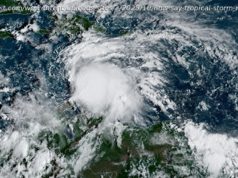Florida’s three most populous counties are in the direct path of a Category 5 hurricane, and officials are telling many residents to leave.
FORT MYERS, Fla. — People in parts of three Florida counties faced mandatory evacuation orders Thursday and officials in two other counties issued voluntary orders to leave in advance of Hurricane Irma, a storm that could create one of the largest mass exoduses in U. S. history as additional evacuations are announced.
The eye of the storm is expected to make landfall Sunday morning in the Florida Keys and travel up the Atlantic coastline, according to the National Hurricane Center.
«Do not sit and wait for this storm to come, » Gov. Rick Scott said. «Get out now.»
► Traffic: Florida gridlock guide maps congestion live ► Where to go?: Floridians fleeing Hurricane Irma face unique challenge ► Pets: How to protect your furry friends during Hurricane Irma
And Florida residents and visitors are doing just that, causing traffic delays on portions of Interstates 95 and 75 and the Florida Turnpike, according to a Google map of traffic-cam data from the Florida Department of Transportation.
• Monroe County, home to the Florida Keys, evacuated 31,000 people as of 6 p.m. Wednesday.
• In Miami-Dade County, Miami Mayor Carlos Gimenez ordered more than 100,000 residents to evacuate their homes on barrier islands such as Miami Beach and low-lying mainland areas starting Thursday morning.
• Broward County, where Fort Lauderdale is the largest city, issued a mandatory evacuation for areas east of U. S. 1, an area with as many as 500,000 residents.
• Brevard County Emergency Management officials announced a mandatory order for more than 100,000 residents living on Merritt Island, an area near the Kennedy Space Center in central Florida, and along the coastal areas to leave their homes and condominiums beginning 3 p.m. Friday.
Nearly 6 million people live in Florida’s three most populous counties — Miami-Dade; Broward; and Palm Beach, the next county northward on the Atlantic coast. Thirteen Florida counties, including Monroe that straddles both coasts, line the Atlantic Ocean, and many have voluntary evacuation orders in place.
«Evacuation orders are going to be given in a timely manner so people have time to evacuate, » Scott said. «But if you wait, that’s when the problems are going to happen.»
► The latest: Where is the Category 5 storm now and where is it headed next? ► History making: All the records Hurricane Irma already has broken
The Hurricane Irma evacuation orders are Florida’s largest since Hurricane Wilma in 2005.
During Hurricane Rita in September 2005, an estimated 2.5 million Houston area residents hit the road in Texas ahead of the storm’s arrival, creating gridlock that lasted for more than 20 hours and killing more than 100 evacuees, according to the Houston Chronicle .
With just two primary highways going north — I-95 along the east coast and I-75 near the west coast — Florida drivers could face tremendous backups. The Florida Turnpike as well as U. S. 27 and smaller roads could have similar fates.
► Weather: How Hurricane Irma grew into a monster ► Preparations: Get your smartphone ready for catastrophic conditions
Fees on the state’s more than 700 miles of toll roads have been suspended to allow traffic to flow more freely.
Officials are striving to keep disabled and abandoned vehicles from becoming a problem.
Any abandoned vehicles will be towed off the Turnpike, according to the Florida Highway Patrol. Plans are being made to do the same thing with any vehicles abandoned on I-95.
«Don’t call for someone to pick you up and leave your car there, » said Sgt. Mark Wysocky, Florida Highway Patrol spokesman. «We want to keep the roadway clear for emergency vehicles to get in.»
Follow Adam Regan on Twitter: @NP_AdamRegan






